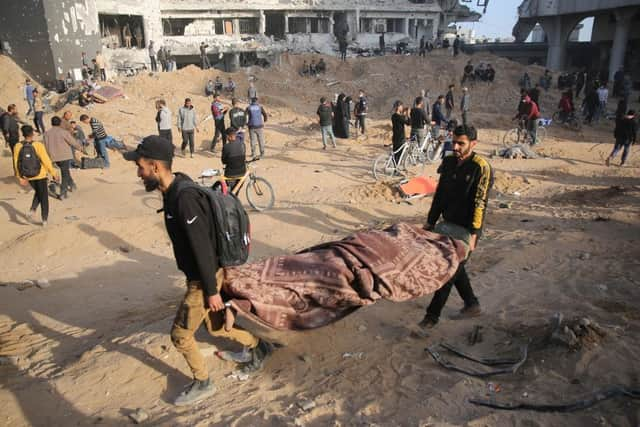Israel-Gaza: Protests continue against Benjamin Netanyahu as the Israeli military leave Gaza's al-Shifa hospital in state of 'total destruction'
Anti-war protests calling for the resignation of Israeli prime minister Benjamin Netanyahu continued for a third day in Tel Aviv as the Israeli army pulled out of a siege on a hospital complex in Gaza, leaving a scene of “total destruction”.
The al-Shifa hospital in Gaza City has been the focus of a two-week raid in which Israel said it killed some 200 militants and detained hundreds more.
Advertisement
Hide AdAdvertisement
Hide AdThis comes as Mr Netanyahu is recovering from weekend surgery for a hernia, which was picked up in a routine examination.


The prime minister said he would be back at work “very quickly”, however, the anaesthetic meant Israel’s leader was temporarily out of action and was officially covered by Israel’s deputy prime minister and justice minister, Yariv Levin.
Palestinian residents said the troops left behind several bodies and a vast swathe of destruction at the hospital.
Mohammed Mahdi, who was among hundreds of Palestinians to return to the area, described a scene of “total destruction”.
He said several buildings had been burned down. He counted six bodies in the area, including two in the hospital courtyard.
Another resident, Yahia Abu Auf, said there were still patients, medical workers and displaced people sheltering inside the medical compound.
He said several patients had been taken to the nearby Ahli Hospital, and that army bulldozers had ploughed over a makeshift cemetery inside the hospital compound.
“The situation is indescribable,” he said. “The occupation destroyed all sense of life here.”
Advertisement
Hide AdAdvertisement
Hide AdThe Israeli army described the raid as one of the most successful operations of the nearly six-month war.
Rear Admiral Daniel Hagari, the country’s top military spokesman, said Hamas and the smaller Islamic Jihad group had established their main northern headquarters inside the hospital.
He described days of close-quarters fighting and blamed Hamas for the destruction, saying some fighters barricaded themselves inside hospital wards while others launched mortar rounds at the compound.
He said the troops arrested 900 suspected militants during the raid, including more than 500 Hamas and Islamic Jihad fighters, and seized more than $3 million (£2.38m) in different currencies, as well as weapons.
He denied that any civilians had been harmed by Israeli forces, saying the army evacuated more than 200 of the estimated 300 to 350 patients and delivered food, water and medical supplies to the rest.
World Health Organisation director-general Tedros Adhanom Ghebreyesus said on Sunday over a hundred patients were still inside the compound, including four children and 28 critical patients. He also said there were no nappies, urine bags or water to clean wounds, and that many patients suffered from infected wounds and dehydration.
A protest in Jerusalem on Sunday night began a four-day vigil by the protesters in front of the Knesset, Israel’s parliament, and followed an anti-government protest in Tel Aviv on Saturday night.
Before the Hamas attacks on 7 October and the launch of Israel’s counter attacks, weekly demonstrations in Tel Aviv routinely brought more than 100,000 people into the streets to protest Mr Netanyahu’s government. However, the protests stopped after the war began.
Comments
Want to join the conversation? Please or to comment on this article.
